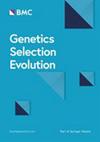大型白猪蛋白质效率和生产性能的单变异全基因组关联研究及区域遗传力定位
IF 3.1
1区 农林科学
Q1 AGRICULTURE, DAIRY & ANIMAL SCIENCE
引用次数: 0
摘要
提高蛋白质效率(PE)是可持续生猪生产的关键因素,因为氮排泄对环境污染有很大影响。蛋白质效率已被证明与饲料系数(FCR)和平均日采食量(ADFI)等性能性状具有遗传和遗传相关性。本研究旨在通过单变全基因组关联研究(GWAS)和区域遗传力定位(RHM),确定与这些性状相关的基因组区域,利用来自1000多头瑞士大白猪的低通测序的全基因组序列变异。使用约1500万个变异的基因组遗传率估计从中等到高,范围从0.33到0.47。GWAS没有发现PE和FCR的显著变异,但在1号染色体上发现了45个ADFI变异,在14号染色体上发现了1个ADG变异。同样,RHM没有检测到PE和FCR的显著区域,但有5个提示ADFI区域(1号染色体)和1个提示ADG区域(14号染色体)。然而,通过结合来自GWAS和RHM的先导信号,即重叠先导变异和重要区域,我们突出了PE的候选基因,包括PHYKPL、COL23A1、PPFIBP2、GVIN1、SYT9、RBMXL2、ZNF215和嗅觉受体基因。结合GWAS和RHM,我们可以确定可能影响PE和生产性状的基因组区域。我们在检测这些性状的显著区域方面的明显困难可能反映了相对较小的样本量,不同研究设计和实验条件下遗传结构的差异,以及解释大部分性状变异的多态性可能不会在该人群中分离。尽管如此,我们在突出的区域中确定了看似可行的功能候选基因,包括那些涉及营养感知、尿素循环和代谢途径的基因,特别是igf1 -胰岛素,这些基因先前被报道与牛的氮代谢、猪的肌肉和脂肪组织代谢和采食量有关。我们还强调了一系列非编码rna。在此背景下,它们的靶点和在基因调控中的作用有待进一步研究。本文章由计算机程序翻译,如有差异,请以英文原文为准。
Single-variant genome-wide association study and regional heritability mapping of protein efficiency and performance traits in Large White pigs
Improvement of protein efficiency (PE) is a key factor for a sustainable pig production, as nitrogen excretion contributes substantially to environmental pollution. Protein efficiency has been shown to be heritable and genetically correlated with performance traits such as feed conversion ratio (FCR) and average daily feed intake (ADFI). This study aimed to identify genomic regions associated with these traits through single-variant genome-wide association studies (GWAS) and regional heritability mapping (RHM) using whole-genome sequence variants from low-pass sequencing of more than 1000 Swiss Large White pigs. Genomic heritability estimates using ~ 15 million variants were moderate to high, ranging from 0.33 to 0.47. GWAS did not identify significant variants for PE and FCR, but identified 45 variants at suggestive significance levels for ADFI on chromosome 1 and one for ADG on chromosome 14. Similarly, RHM detected no significant regions for PE and FCR, but five suggestive regions for ADFI (chromosome 1) and one for ADG (chromosome 14). However, by combining leading signals from GWAS and RHM, i.e. overlapping leading variants and significant regions, we highlighted putative candidate genes for PE, including PHYKPL, COL23A1, PPFIBP2, GVIN1, SYT9, RBMXL2, ZNF215, and olfactory receptor genes. Combining GWAS and RHM allowed us to identify genomic regions that may influence PE and production traits. Our apparent difficulty in detecting significant regions for these traits probably reflects the relatively small sample size, differences in genetic architecture across study designs and experimental conditions, and that polymorphisms explaining large proportions of the trait variation may not segregate in this population. Nevertheless, we identified plausible functional candidate genes in the highlighted regions, including those involved in nutrient sensing, the urea cycle, and metabolic pathways, in particular IGF1-insulin, and that have previously been reported to be associated with nitrogen metabolism in cattle and with muscle and adipose tissue metabolism and feed intake in pigs. We also highlighted a range of noncoding RNAs. Their targets and roles in gene regulation should be further investigated in this context.
求助全文
通过发布文献求助,成功后即可免费获取论文全文。
去求助
来源期刊

Genetics Selection Evolution
生物-奶制品与动物科学
CiteScore
6.50
自引率
9.80%
发文量
74
审稿时长
1 months
期刊介绍:
Genetics Selection Evolution invites basic, applied and methodological content that will aid the current understanding and the utilization of genetic variability in domestic animal species. Although the focus is on domestic animal species, research on other species is invited if it contributes to the understanding of the use of genetic variability in domestic animals. Genetics Selection Evolution publishes results from all levels of study, from the gene to the quantitative trait, from the individual to the population, the breed or the species. Contributions concerning both the biological approach, from molecular genetics to quantitative genetics, as well as the mathematical approach, from population genetics to statistics, are welcome. Specific areas of interest include but are not limited to: gene and QTL identification, mapping and characterization, analysis of new phenotypes, high-throughput SNP data analysis, functional genomics, cytogenetics, genetic diversity of populations and breeds, genetic evaluation, applied and experimental selection, genomic selection, selection efficiency, and statistical methodology for the genetic analysis of phenotypes with quantitative and mixed inheritance.
 求助内容:
求助内容: 应助结果提醒方式:
应助结果提醒方式:


